[Esp]Estiremos y fortalezcamos los músculos del cuello y de las cervicales./[Eng]Let's stretch and strengthen the neck and cervical muscles.
El cuello es una importante parte del cuerpo, que debemos cuidar, con la finalidad de evitar tensión muscular y dolores. Sus músculos contribuyen en sostener la cabeza y en ciertos movimientos del omóplato, el cual es uno de los dos huesos triangulares de la parte de atrás del hombro. Los músculos del cuello, así como también, las estructuras cervicales ubicadas en la parte superior de la columna vertebral; son sometidos, muchas veces, a esfuerzos o movimientos inadecuados, generando diversas molestias como; dolores de cabeza, vértigo, mareos, tensión de la mandíbula, limitación en ciertos movimientos y la denominada cervicalgia, causante de dolencias que afectan a el cuello. Existen diversas causas mediante las cuales el cuello y las cervicales, son afectados, entre las cuales se destacan; el estrés, malas posturas, distensiones o desgarros musculares, por tales razones, son importantes los ponderados estiramientos en las citadas zonas, los cuales son efectivos para minimizar la probabilidad de lesiones en el cuello y la cervical, permitiendo la flexibilidad de los músculos de la mencionada región, ayudando a disminuir dolores, corregir la postura, mejorar la flexibilidad y la amplitud de movimiento en el cuello, así como también equilibrar el cuerpo, repercutiendo en un buen estado de ánimo. En ese orden de ideas, para estirar y fortalecer los músculos del cuello y las cervicales, ayudando a prevenir y solventar los males señalados, comparto con ustedes una importante asana y sus variantes, las cuales también son muy efectivas para equilibrar el cuerpo y mejorar la postura, ellas son; el medio puente o Setu Bandha Sarvangasana y sus variantes, las cuales se realizan de la siguiente manera; manteniendo el cuerpo invertido, apoyamos la cabeza, la parte alta de la espalda y la planta del pie derecho en la esterilla, cruzamos la pierna izquierda por encima de la pierna derecha, colocando la mano derecha en el pie izquierdo, luego pasamos el brazo izquierdo por el pecho, poniendo la mano en el brazo derecho. Seguidamente, ubicados en la posición anterior, cumpliremos con el desarrollo de otra variante, en esta ocasión, apoyando la parte superior de la planta del pie derecho. Dichas posturas también son muy buenas, para aumentar la capacidad pulmonar, al generar el fortalecimiento de los músculos del pecho, igualmente son muy recomendadas para aliviar los dolores de cabeza, estimular los órganos abdominales y mejorar el proceso digestivo, aunado a que contribuyen a tonificar la zona pélvica y flexibilizar los músculos de la cadera. Con las asanas descritas, también mejoramos el sueño y se reduce el insomnio, calman la mente y alivian el estrés. Acompáñenme, en tan desafiantes posturas, para seguir con nuestra sanación física y mental. Éxitos.
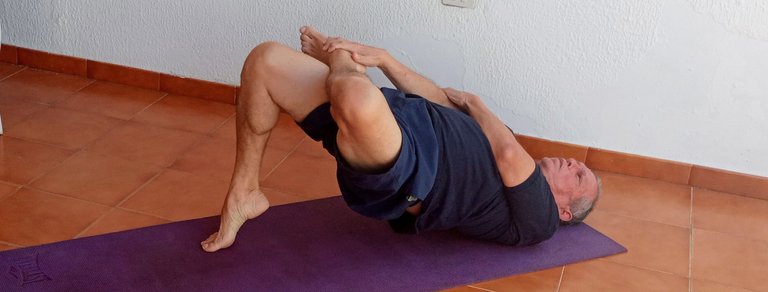
The neck is an important part of the body, which we must take care of, in order to avoid muscle tension and pain. Its muscles contribute to supporting the head and certain movements of the scapula, which is one of the two triangular bones at the back of the shoulder. The muscles of the neck, as well as the cervical structures located in the upper part of the spine; They are often subjected to inappropriate efforts or movements, generating various discomforts such as; headaches, vertigo, dizziness, jaw tension, limitation in certain movements and the so-called cervicalgia, which causes ailments that affect the neck. There are various causes by which the neck and cervical are affected, among which stand out; stress, poor posture, strains or muscle tears, for these reasons, weighted stretching in the aforementioned areas is important, which are effective in minimizing the probability of neck and cervical injuries, allowing the flexibility of the muscles of the mentioned region, helping to reduce pain, correct posture, improve flexibility and range of motion in the neck, as well as balance the body, resulting in a good mood. In that order of ideas, to stretch and strengthen the neck and cervical muscles, helping to prevent and solve the aforementioned ills, I share with you an important asana and its variants, which are also very effective in balancing the body and improving the posture, they are; the half bridge or Setu Bandha Sarvangasana and its variants, which are performed as follows; keeping the body inverted, we support the head, the upper part of the back and the sole of the right foot on the mat, we cross the left leg over the right leg, placing the right hand on the left foot, then we pass the left arm across the chest, putting the hand on the right arm. Next, located in the previous position, we will carry out the development of another variant, this time, supporting the upper part of the sole of the right foot.These postures are also very good, to increase lung capacity, by generating the strengthening of the chest muscles, they are also highly recommended to relieve headaches, stimulate the abdominal organs and improve the digestive process, in addition to contributing to tone the pelvic area and make the hip muscles more flexible. With the asanas described, we also improve sleep and reduce insomnia, calm the mind and relieve stress. Join me, in such challenging postures, to continue with our physical and mental healing. Successes.
Iniciamos con el proceso de Meditación
Es muy importante meditar para entrenar la mente, respirando sanamente, previo al proceso de calentamiento corporal, para relajarnos y lograr alcanzar la paz, lo haremos aplicando la postura, que se indica a continuación; sentados con la espalda derecha, entrecruzamos las piernas delante del cuerpo, levantando los brazos, juntamos las palmas de las manos en señal de oración, seguidamente procedemos a reflexionar e interanalizar las siguientes ideas: 1)"Todo en la vida mejora, cuando en lugar de enojarte, te apartas de lo que puede dañarte". 2)"El tiempo no tiene que poner nada en su lugar, somos nosotros quienes debemos elegir el tiempo para actuar". 3)"Nunca olvidemos de ser coherentes, con lo que pensamos, decimos y hacemos". 4)"Ser puntual, genuino, respetuoso, grato y cortés, abre más puertas de lo que nosotros podamos imaginar". Éxitos.
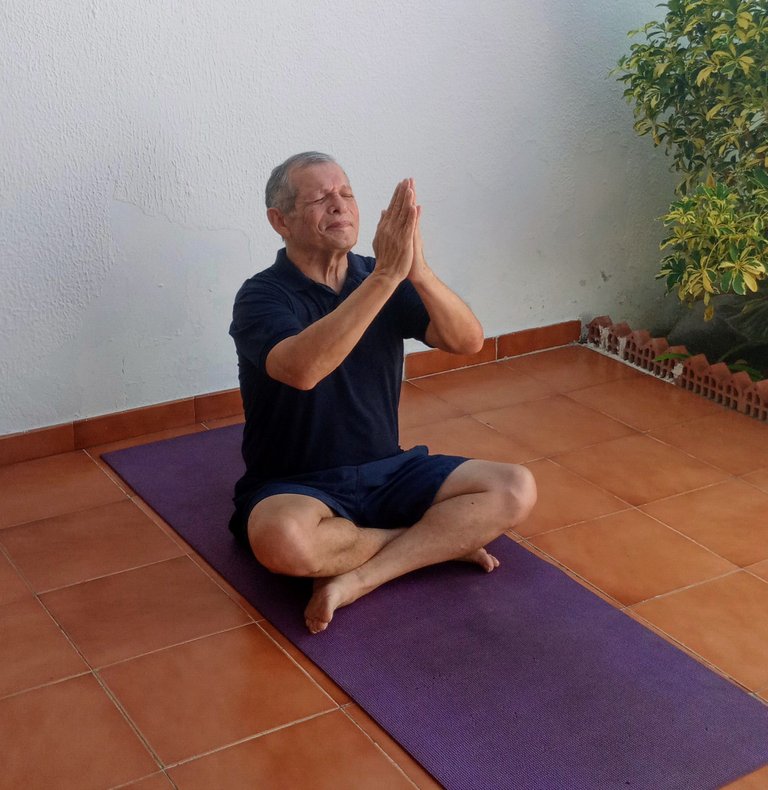
We start with the Meditation process
It is very important to meditate to train the mind, breathing healthily, prior to the body warm-up process, to relax and achieve peace, we will do it by applying the posture indicated below; Sitting with our backs straight, we cross our legs in front of the body, raising our arms, we join the palms of our hands as a sign of prayer, then we proceed to reflect and interanalyze the following ideas: 1) "Everything in life improves, when instead of to get angry, you turn away from what can harm you. 2) "Time does not have to put anything in its place, we are the ones who must choose the time to act". 3) "Never forget to be consistent with what we think, say and do." 4) "Being punctual, genuine, respectful, pleasant and courteous, opens more doors than we can imagine." successes.
Cumplimiento del calentamiento corporal
Con el propósito de alcanzar un buen rendimiento, evitar lesiones, flexibilizar los músculos y articulaciones, iniciamos a calentar el cuerpo, con acciones suaves para equilibrarnos y comenzar a fortalecer los músculos de la espalda, del abdomen, piernas y brazos. Dichos movimientos tendrán una duración de 12 minutos, descansando 10 segundos por cada dos minutos de ellos, los mismos, se indican a continuación:
Estando sentados con la espalda derecha, las piernas entrecruzadas delante del cuerpo, los brazos estirados al frente, entrelazando los dedos de las manos, conjuntamente con ellas, extendemos los brazos hacia arriba. Ubicados en dicha postura, flexionamos suavemente el torso lateralmente, hacia la derecha y luego a la izquierda.
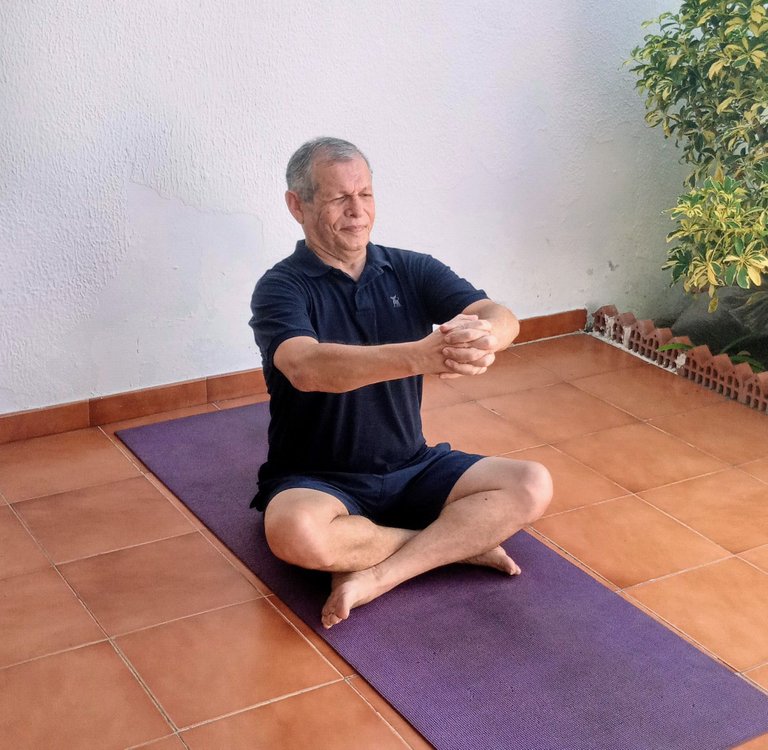
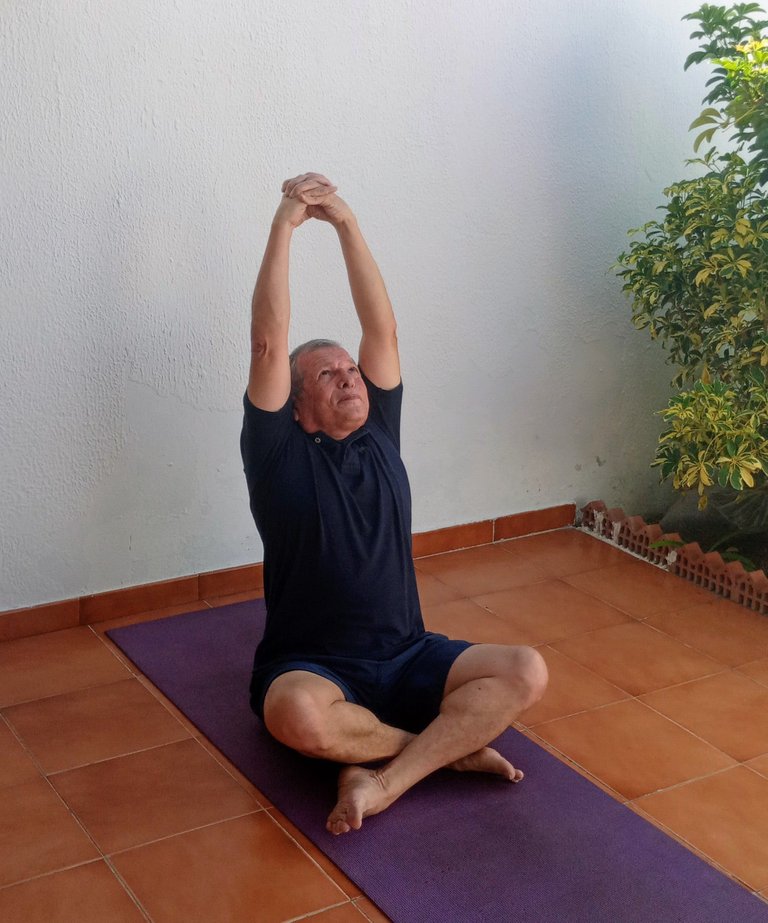
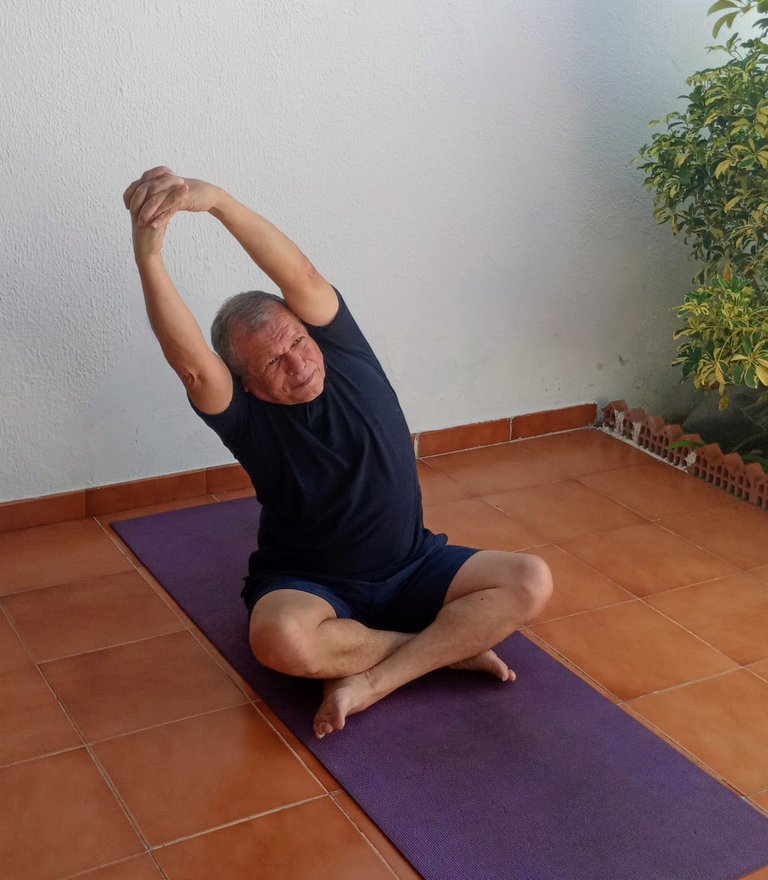
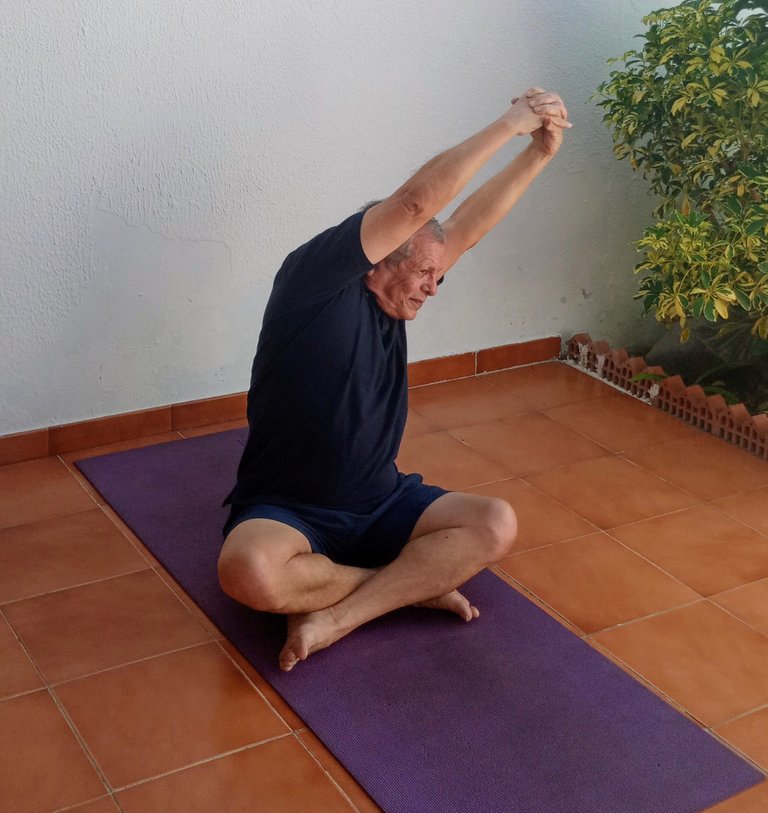
Body Warming Compliance
In order to achieve good performance, avoid injuries, and make muscles and joints more flexible, we begin to warm up the body, with gentle actions to balance ourselves and begin to strengthen the muscles of the back, abdomen, legs, and arms. These movements will have a duration of 12 minutes, resting 10 seconds for every two minutes of them, they are indicated below:
Sitting with your back straight, your legs crossed in front of your body, your arms stretched out in front, interlocking your fingers together with them, you extend your arms upwards. Located in this posture, we gently flex the torso laterally, to the right and then to the left.
Continuamos sentados con la espalda derecha, las piernas entrecruzadas, ubicados en la posición inicial, suavemente flexionamos el torso diagonalmente, apuntando con las manos entrelazadas a la derecha, seguidamente a la izquierda, para finalmente apuntar con ellas hacia el centro delante del cuerpo. Los citados movimientos, los repetiremos en atención al tiempo señalado, con sus respectivos segundos de descanso. Éxitos.
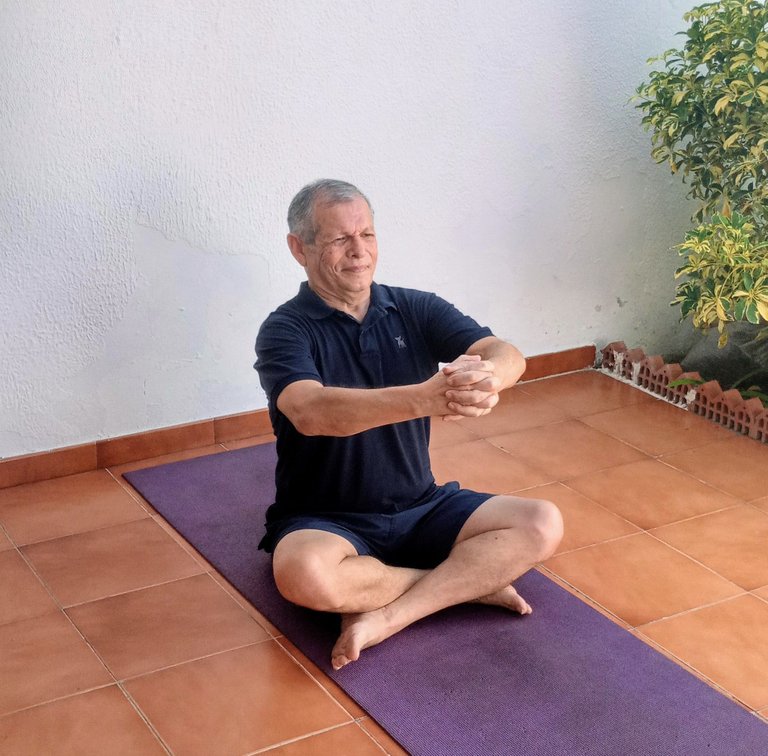
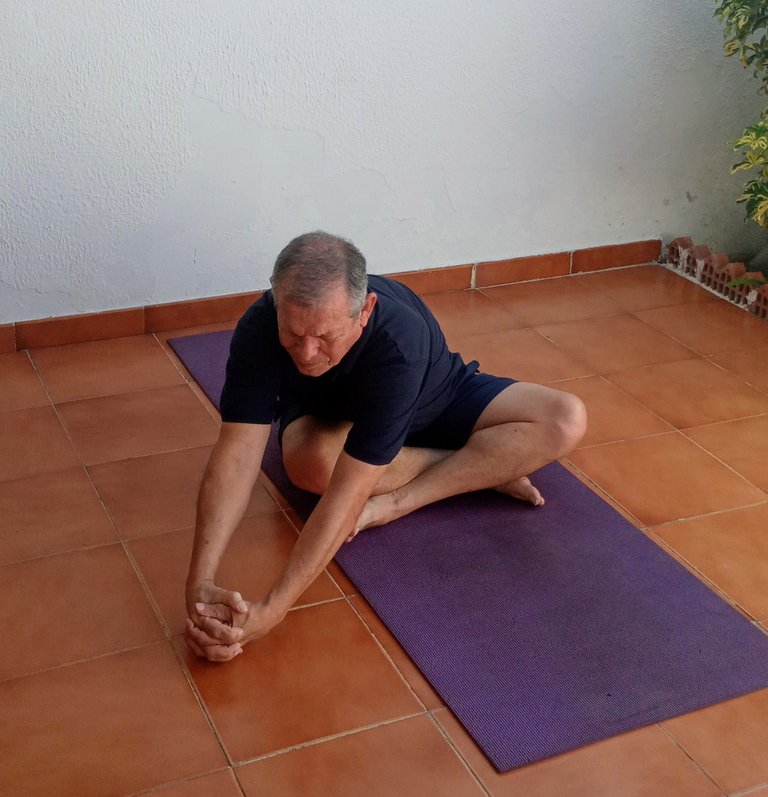
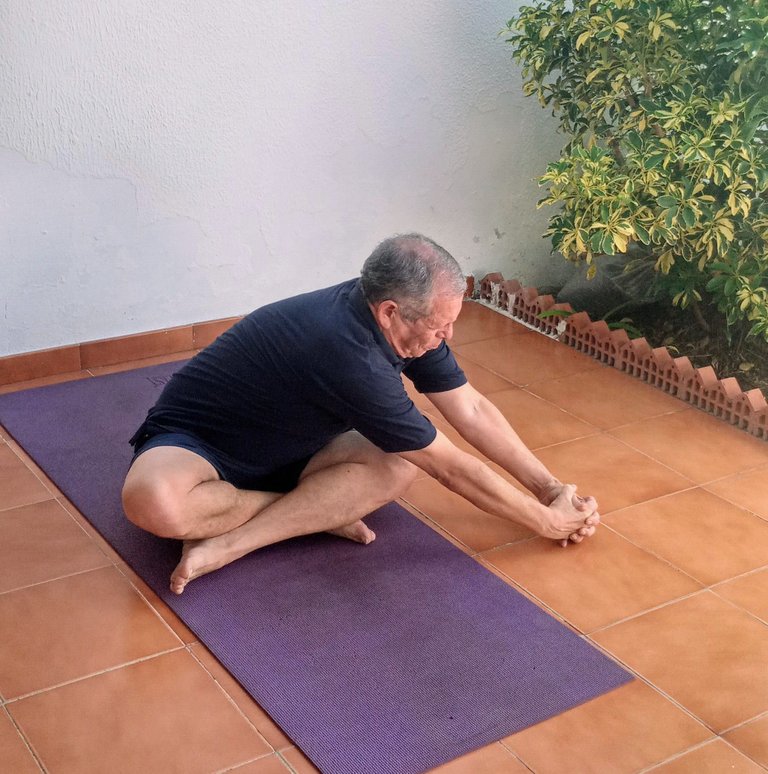
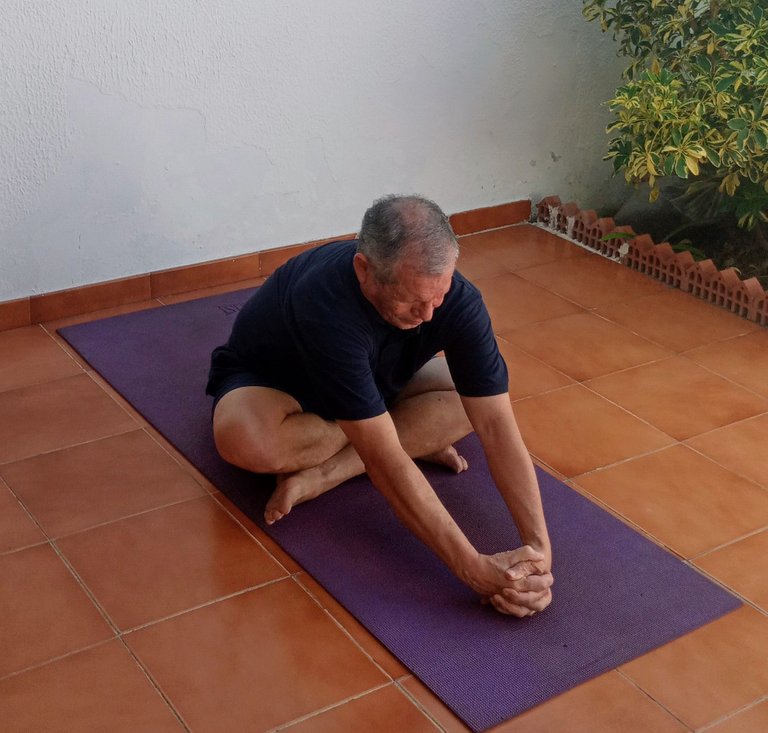
We continue sitting with our back straight, legs crossed, located in the initial position, we gently flex our torso diagonally, pointing with our intertwined hands to the right, then to the left, to finally point them towards the center in front of the body. The aforementioned movements will be repeated according to the indicated time, with their respective seconds of rest. Successes.
Desarrollo de la postura el medio puente o Setu Bandha Savangasana y sus variantes, las cuales se realizan de la siguiente manera; manteniendo el cuerpo invertido, apoyamos la cabeza, la parte alta de la espalda y la planta del pie derecho en la esterilla, cruzamos la pierna izquierda por encima de la pierna derecha, colocando la mano derecha en el pie izquierdo, luego pasamos el brazo izquierdo por el pecho, poniendo la mano en el brazo derecho. Para cumplir con el desarrollo de otra variante, en esta ocasión, apoyando la parte superior de la planta del pie derecho
Sentados con la espalda derecha, los brazos a los lados del cuerpo y las manos apoyadas en la esterilla, extendemos las piernas hacia delante, ubicándonos en la asana el bastón o Dandasana, seguidamente doblamos las piernas, direccionando los talones de los pies hacia las caderas, flexionando el torso hacia atrás, con las manos en la esterilla, a los lados detrás del cuerpo, a continuación suavemente reclinamos el torso plenamente hacia atrás, apoyando la espalda y la cabeza en la esterilla, con los brazos a los lados. Equilibrados inspiramos aguantamos y expulsamos aire. Éxitos
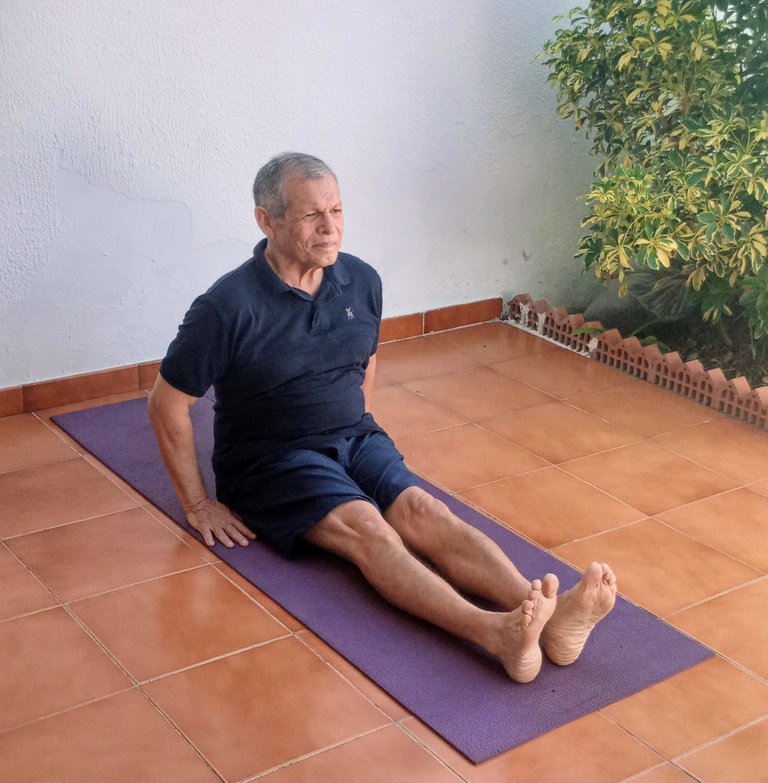

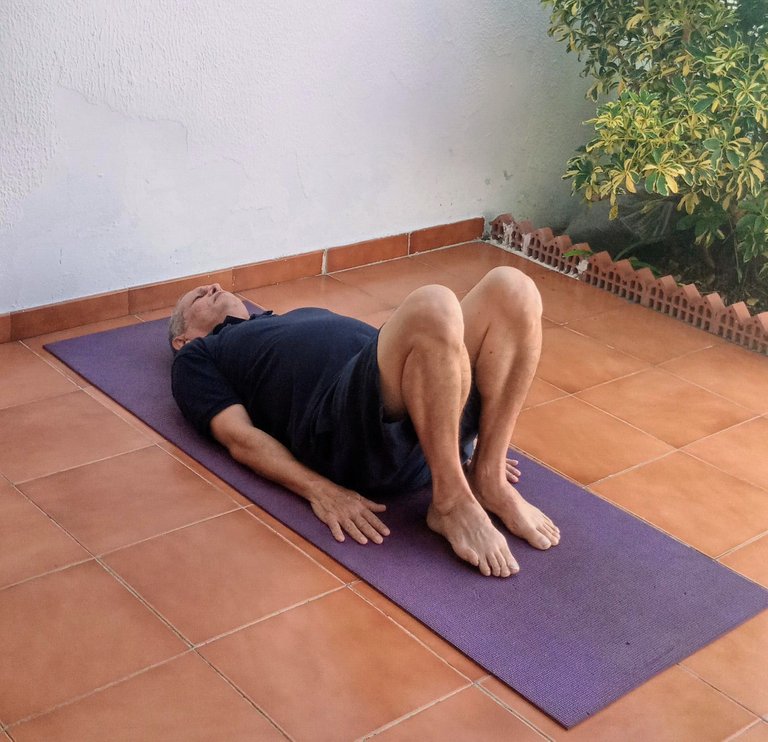
Development of the half bridge or Setu Bandha Sarvangasana and its variants, which are performed as follows; keeping the body inverted, we support the head, the upper part of the back and the sole of the right foot on the mat, we cross the left leg over the right leg, placing the right hand on the left foot, then we pass the left arm across the chest, putting the hand on the right arm. To comply with the development of another variant, this time, supporting the upper part of the sole of the right foot
Sitting with the back straight, arms by the sides of the body and hands resting on the mat, we extend the legs forward, placing the staff or Dandasana in the asana, then bend the legs, directing the heels of the feet towards the hips , flexing the torso backwards, with the hands on the mat, on the sides behind the body, then gently recline the torso fully backwards, supporting the back and the head on the mat, with the arms at the sides. Balanced we inspire hold and expel air. Successes.
Desde la ubicación anterior, logramos la postura el medio puente o Setu Bandha Sarvangasana, despegando los glúteos de la esterilla, elevamos las caderas, quedando el cuerpo apoyando en dicha esterilla, la cabeza, la parte alta de la espalda y los pies, con los brazos a los lados, durando en la asana 30 segundos, equilibrados inspiramos, aguantamos y expulsamos aire. Éxitos.
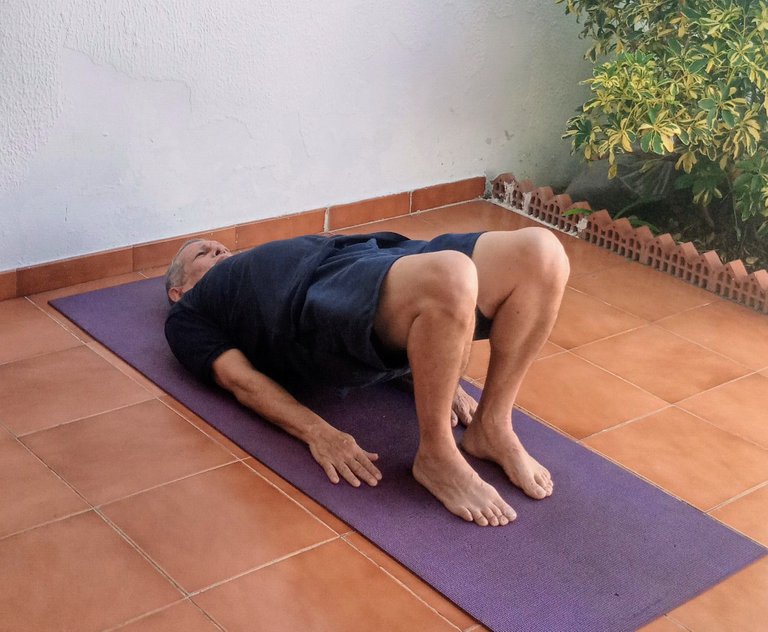
From the previous location, we achieve the half bridge posture or Setu Bandha Sarvangasana, taking off the buttocks from the mat, we raise the hips, leaving the body resting on said mat, the head, the upper part of the back and the feet, with the arms at the sides, lasting in the asana 30 seconds, balanced we inspire, hold and expel air. Successes.
A continuación conformamos la variante del medio puente o Setu Bandha Sarvangasana, de la siguiente manera; estando en la posición el medio puente o Setu Bandha Sarvangasana, despegamos el pie izquierdo de la esterilla, elevamos y flexionamos la pierna de dicho lado, para apoyar el pie lateralmente en el muslo de la pierna derecha, seguidamente alzamos la mano derecha de la esterilla, apoyándola antes o en el tobillo del pie izquierdo, luego levantamos el brazo izquierdo, para cruzarlo por el pecho, colocando la mano en el brazo derecho, el cual se encuentra estirado. Durando 30 segundos en la postura, equilibrados y en resistencia corporal, inspirando, aguantando y expulsando aire. Éxitos.
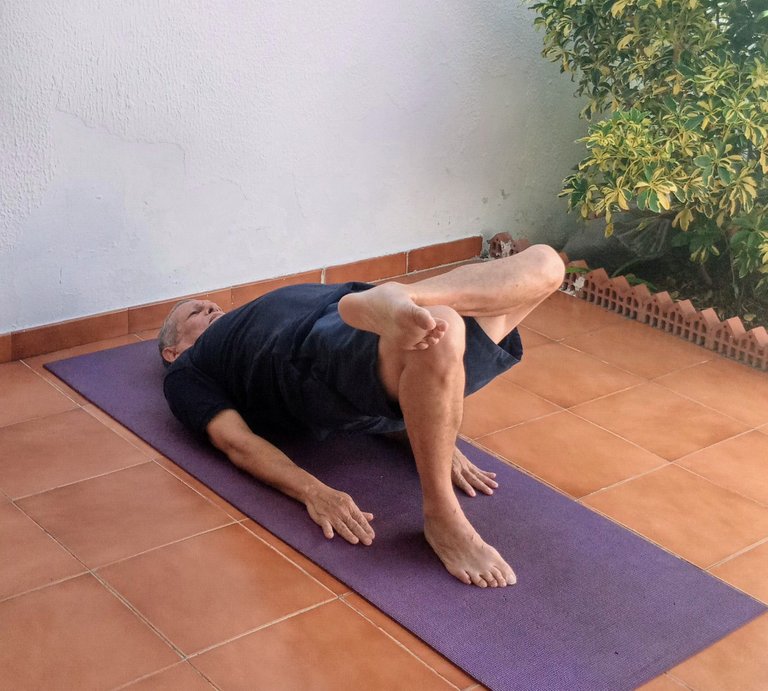
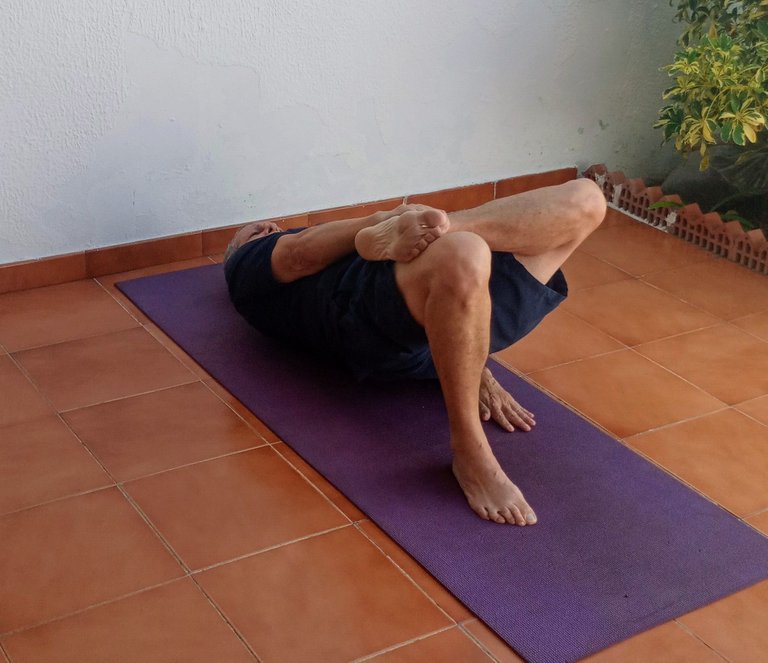
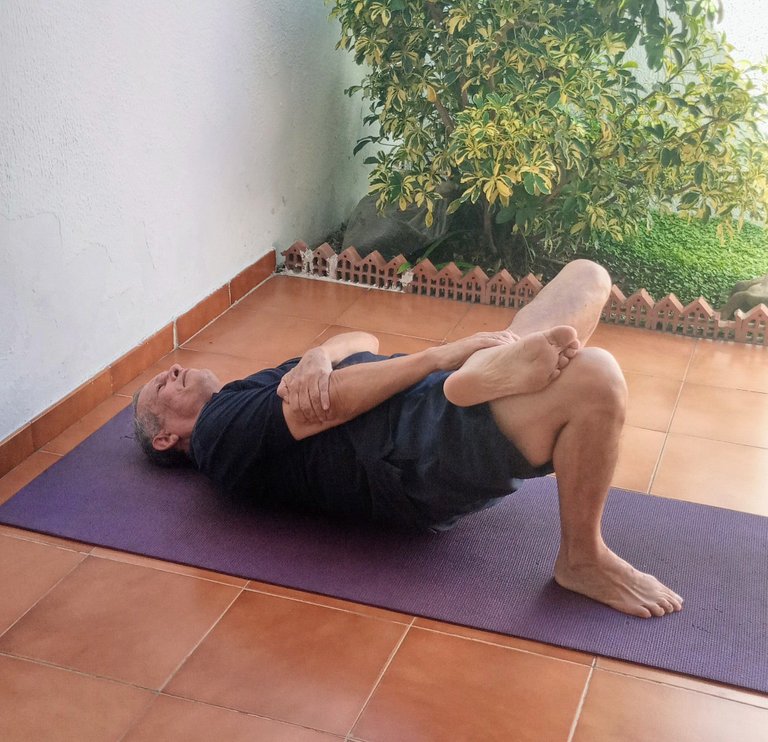
Next, we form the variant of the half bridge or Setu Bandha Sarvangasana, in the following way; being in the half bridge or Setu Bandha Sarvangasana position, we take off the left foot from the mat, raise and flex the leg on that side, to support the foot laterally on the thigh of the right leg, then raise the right hand from the mat, supporting it before or at the ankle of the left foot, then we raise the left arm, to cross it across the chest, placing the hand on the right arm, which is stretched out. Lasting 30 seconds in the posture, balanced and in body resistance, inhaling, holding and expelling air. Successes.
Es oportuno, presentarles otra variante del medio puente o Setu Bandha Sarvangasana, derivada de la postura anterior, según la descripción indicada; es decir con el cuerpo apoyando en la esterilla, la cabeza, la espalda y la planta del pie derecho, alzamos la mano derecha de la esterilla, apoyándola antes o en el tobillo del pie izquierdo, luego levantamos el brazo izquierdo, para cruzarlo por el pecho, colocando la mano en el brazo derecho, el cual se encuentra estirado, sin hacer mucha tensión, suavemente, lograremos la mencionada variante, con tranquilidad, evitando algún desgarramiento muscular, procediendo a levantar con tranquilidad, el talón del citado pie derecho, para dejar asentando en dicha esterilla, solamente la parte superior de la planta del pie, como se evidencia en la siguiente imagen, durando en la asana 30 segundos, equilibrados y en resistencia corporal, inspirando, aguantando y expulsando aire. Estimados, si no podemos desarrollar la variante descrita, con la otra es suficiente, prontamente la cumpliremos. Éxitos.
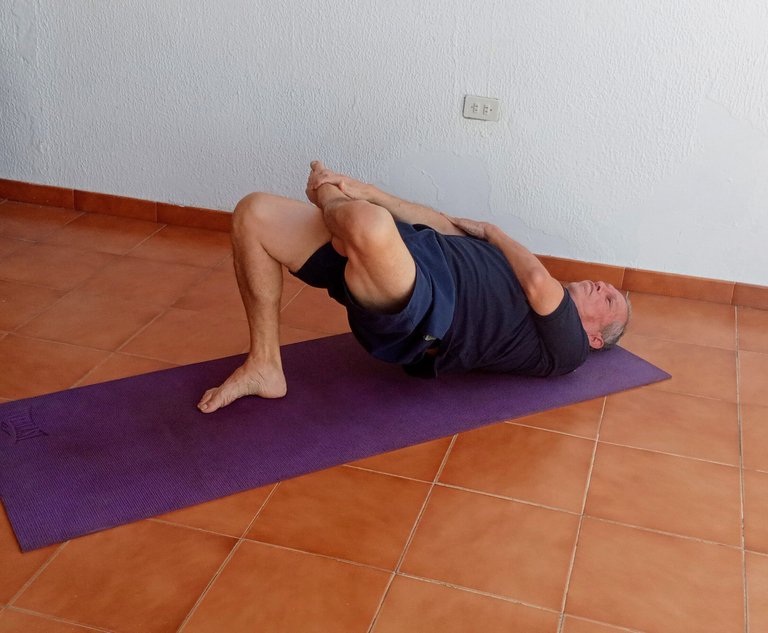
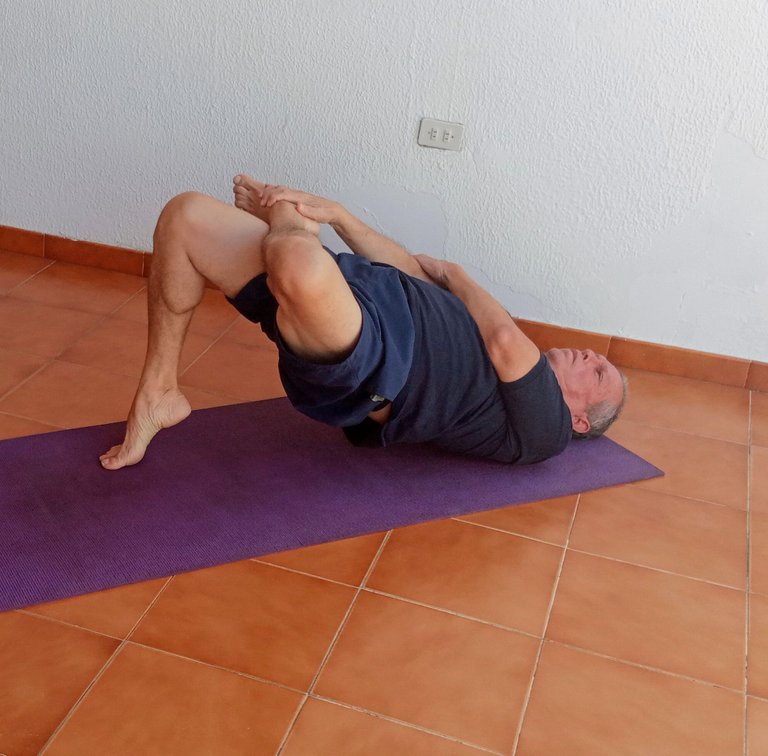
It is timely to present another variant of the half bridge or Setu Bandha Sarvangasana, derived from the previous position, according to the indicated description; that is, with the body resting on the mat, the head, the back and the sole of the right foot, we raise the right hand from the mat, supporting it before or on the ankle of the left foot, then we raise the left arm, to cross it by the chest, placing the hand on the right arm, which is stretched, without making much tension, gently, we will achieve the aforementioned variant, calmly, avoiding any muscle tearing, proceeding to calmly lift the heel of the aforementioned right foot, to leave only the upper part of the sole of the foot resting on said mat, as evidenced in the following image, lasting in the asana for 30 seconds, balanced and in body resistance, inhaling, holding and expelling air. Dear, if we cannot develop the variant described, the other is enough, we will soon comply. Successes.
Repetimos la asana Setu Bandha Sarvangasana o el medio puente y su variante inicial, de la siguiente manera; estando en la posición el medio puente o Setu Bandha Sarvangasana, despegamos el pie derecho de la esterilla, elevamos y flexionamos la pierna de dicho lado, para apoyar el pie lateralmente en el muslo de la pierna izquierda, seguidamente despegamos la mano izquierda de la esterilla, apoyándola antes del tobillo de la pierna derecha, además logramos levantar el brazo derecho, para cruzarlo por el pecho y apoyar la mano en el brazo izquierdo, que se encuentra estirado. Durando 30 segundos en la postura, equilibrados y en resistencia corporal, inspirando, aguantando y expulsando aire. Éxitos.
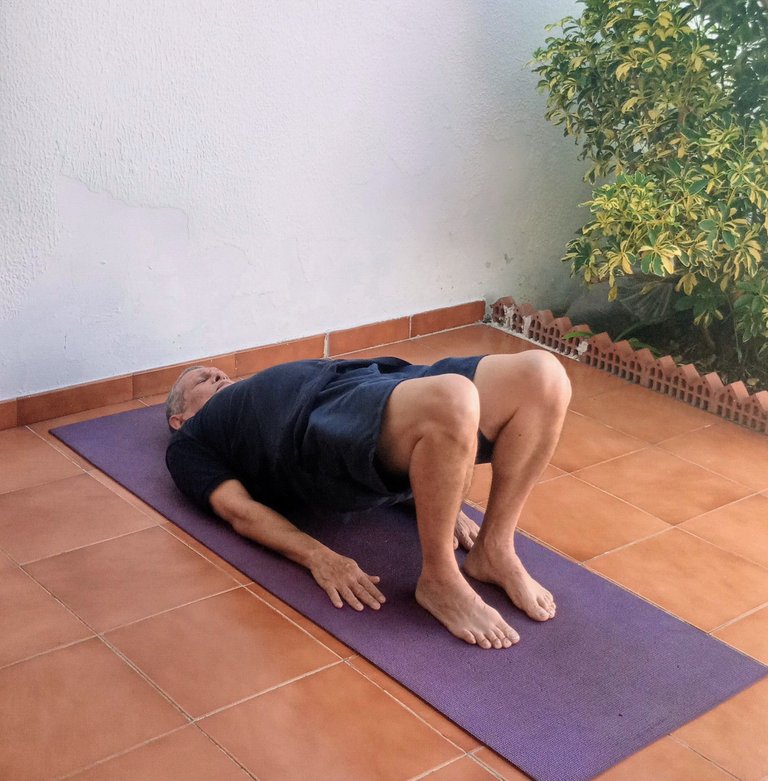
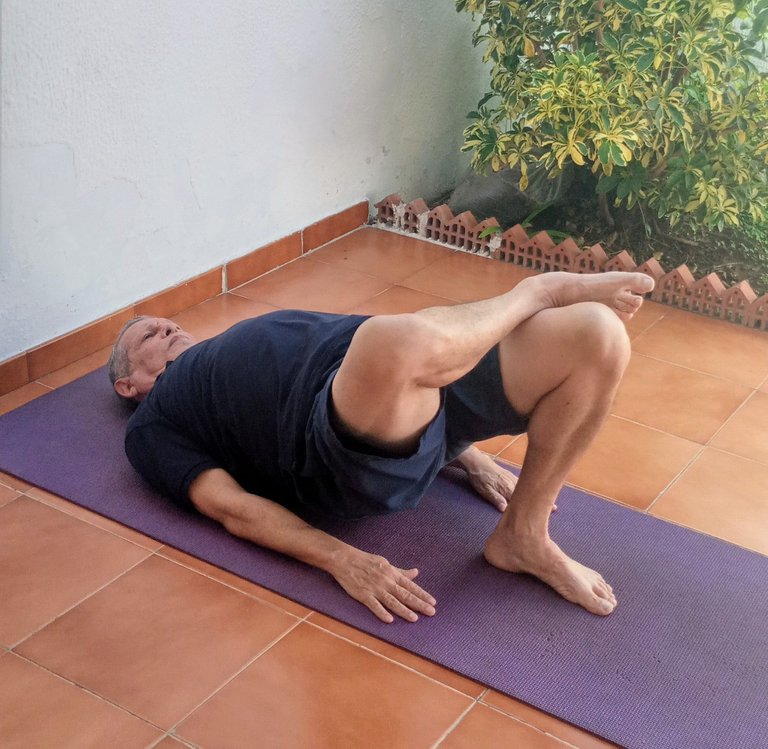
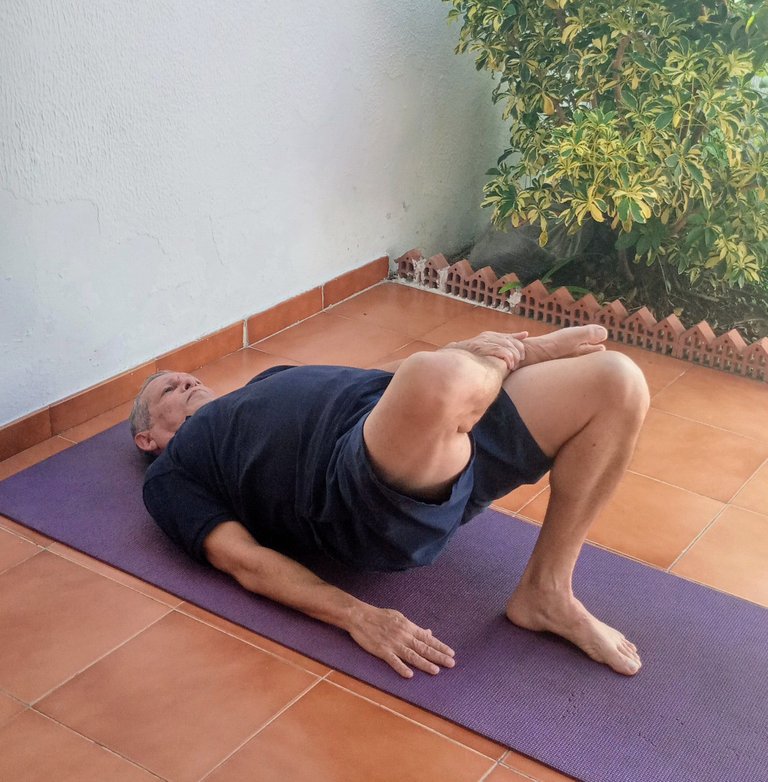
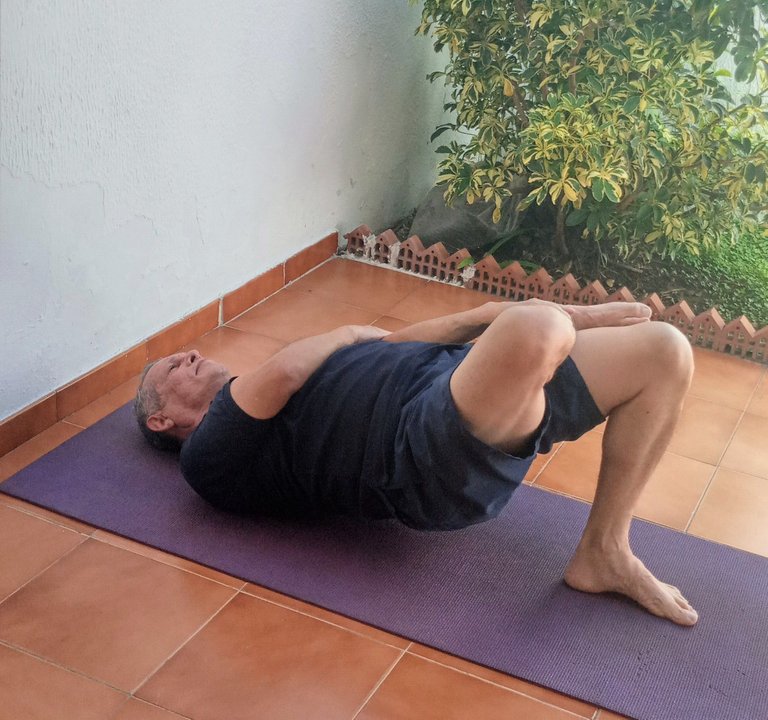
We repeat the asana Setu Bandha Sarvangasana or the half bridge and its initial variant, as follows; Being in the bridge or Setu Bandha Sarvangasana position, we take off the right foot from the mat, raise and flex the leg on that side, to support the foot laterally on the thigh of the left leg, then take off the left hand from the mat, supporting it before of the ankle of the right leg, we were also able to raise the right arm, to cross it across the chest and rest the hand on the left arm, which is stretched out. Lasting 30 seconds in the posture, balanced and in body resistance, inhaling, holding and expelling air. Successes.
Beneficios de las posturas el puente o Setu Bandha Sarvangasana y sus variantes, las cuales se realizan de la siguiente manera; manteniendo el cuerpo invertido, apoyamos la cabeza, la parte alta de la espalda y la planta del pie derecho en la esterilla, cruzamos la pierna izquierda por encima de la pierna derecha, colocando la mano derecha en el pie izquierdo, luego pasamos el brazo izquierdo por el pecho, poniendo la mano en el brazo derecho. Para cumplir con el desarrollo de otra variante, en esta ocasión, apoyamos la parte superior de la planta del pie derecho
- Contribuyen con el estiramiento de los músculos del cuello y la zona cervical.
- Son efectivas para mejorar el equilibrio y la postura.
- Son buenas para aumentar la capacidad pulmonar, al generar el fortalecimiento de los músculos del pecho.
- Las estudiadas asanas son muy recomendadas, por su efectividad para aliviar los dolores de cabeza.
- Con ellas, se estimulan los órganos abdominales, mejorando el proceso digestivo.
- Contribuyen a tonificar la zona pélvica y flexibilizar los músculos de la cadera.
- Son muy recomendadas para mejorar el sueño y minimizar el insomnio.
- Son útiles para calmar la mente y aliviar el estrés.
Benefits of the half bridge postures or Setu Bandha Sarvangasana and its variants, which are performed as follows; keeping the body inverted, we support the head, the upper part of the back and the sole of the right foot on the mat, we cross the left leg over the right leg, placing the right hand on the left foot, then we pass the left arm across the chest, putting the hand on the right arm. To comply with the development of another variant, this time, supporting the upper part of the sole of the right foot
- They contribute to the stretching of the muscles of the neck and the cervical area.
- They are effective in improving balance and posture.
- They are good for increasing lung capacity, by generating the strengthening of the chest muscles.
- The studied asanas are highly recommended for their effectiveness in relieving headaches.
- With them, the abdominal organs are stimulated, improving the digestive process.
- They help tone the pelvic area and make the hip muscles more flexible.
- They are highly recommended to improve sleep and minimize insomnia.
- They are useful for calming the mind and relieving stress.
Estimados amigos, cuando tengamos la posibilidad de generar el estiramiento de los músculos del cuello y la zona cervical, son muy recomendadas las asanas el medio puente o Setu Bandha Sarvangasana y sus variantes, las cuales también ayudan a mejorar el equilibrio y la postura, beneficios muy importantes, en especial a medida que avanzamos en edad, aunado a que contribuyen a aumentar la capacidad pulmonar, generando el fortalecimiento de los músculos del pecho. Igualmente, amigos, cuando tengamos, dolores de cabeza muy acentuados, dichas posturas son muy buenas calmantes, asimismo son nuestras aliadas para los momentos de tener inconvenientes con los procesos digestivos. Las estudiadas, asanas también son importantes por ayudar a tonificar la zona pélvica y flexibilizar los músculos de la cadera, además con sus reiteradas prácticas, mejoramos el sueño y se reduce el insomnio, al igual que son útiles para calmar la mente y aliviar el estrés. En tal sentido, debemos desarrollar su ejercitación como de rutina, por los saludables efectos, para nuestro organismo. Amigos, al agradecerles su receptividad y visita, me suscribo a ustedes, con mucho afecto. Omar Gustavo Rojas Ortiz desde la ciudad de Cumaná en el estado Sucre-Venezuela.
Dear friends, when we have the possibility of generating the stretching of the muscles of the neck and the cervical area, the half bridge asanas or Setu Bandha Sarvangasana and its variants are highly recommended, which also help improve balance and posture, benefits very important, especially as we advance in age, in addition to contributing to increasing lung capacity, generating the strengthening of the chest muscles. Similarly, friends, when we have severe headaches, these postures are very good calming, they are also our allies for times of having problems with digestive processes. The studied asanas are also important for helping to tone the pelvic area and make the hip muscles more flexible, in addition to their repeated practices, we improve sleep and reduce insomnia, just as they are useful for calming the mind and relieving stress. . In this sense, we must develop its exercise as a routine, for the healthy effects, for our body. Friends, in thanking you for your receptivity and visit, I subscribe to you, with great affection. Omar Gustavo Rojas Ortiz from the city of Cumaná in the state of Sucre-Venezuela.
Las imágenes fueron tomadas por Nancy de Rojas con mi celular Samsung Galaxy A10s y la publicación es de mi autoría.
The images were taken by Nancy de Rojas with my Samsung Galaxy A10s cell phone and the publication is my own.
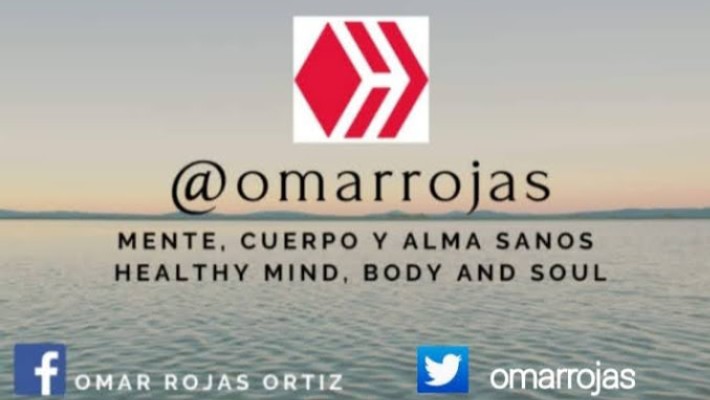
https://twitter.com/Omarroj52318483/status/1553414242761580544
The rewards earned on this comment will go directly to the people sharing the post on Twitter as long as they are registered with @poshtoken. Sign up at https://hiveposh.com.
Actualmente me da mucho dolor en cuello cuando paso mucho tiempo sentado o haciendo alguna actividad, tal vez sea por falta de ejercicios. Esto me será bastante útil, muchas gracias por compartir esta rutina de estiramientos para tener fortalecido los músculos de la zona ya menciona.
Muy buen trabajo, el post está muy bien explicado, con el paso a paso de lo que debemos hacer y con una muy buena fotografías.
Saludos!
Gracias estimado @franz54 se agradecen sus bonitas palabras, sobre mi publicación. Deseo que la practiques y obtengas los resultados deseados para tus dolores de cuello, incluso los ejercicios de calentamientos también te ofrecen ayuda para mejorar las cervicales. Éxitos
muy bueno la rutina de estiramiento @omarrojas. Te felicito😁
Gracias estimado amigo @chanekydibujos por visitarme y comentar. Espero, lo apliques, éxitos para ti.
De nada amigo, igualmente éxitos para usted también😁